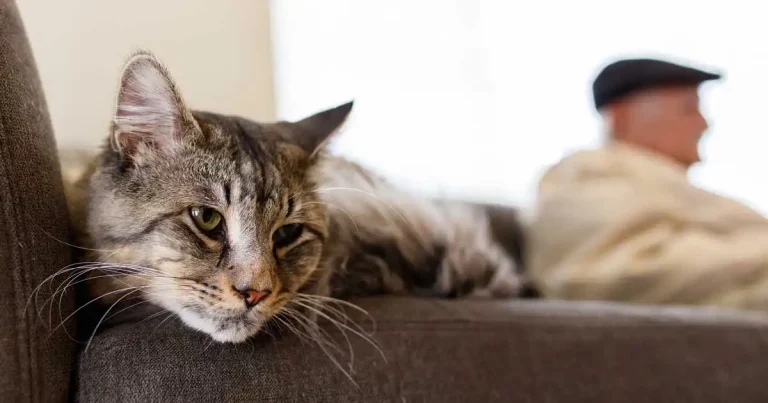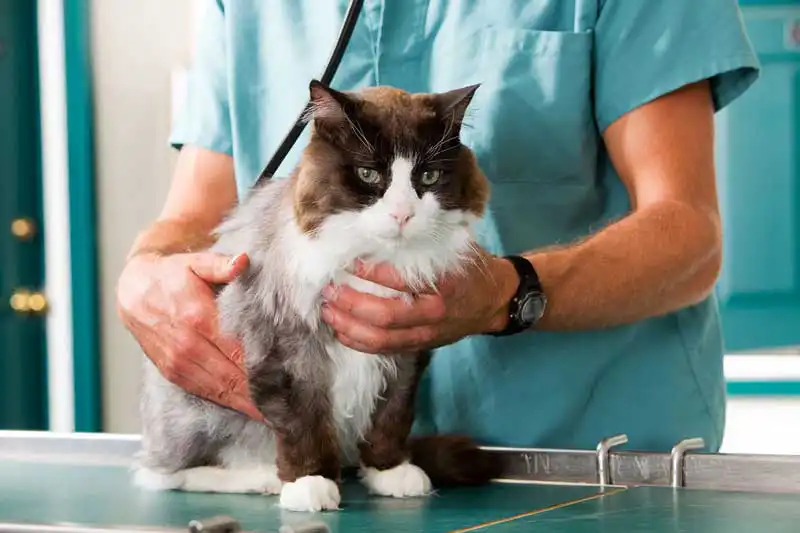8 Jul 2025
Senior cats: how practices can work with owners
Lauren Demos BVSc, BVMS(Hons), DABVP(Feline), MRCVS discusses the many ways vet professionals can work with clients to support them in managing key issues in older patients.

Image: Adobe Stock / Fotoluminate LLC
As veterinary science continues to expand its breadth of knowledge regarding feline gerontology, feline patients are living longer than ever as a result.
The average lifespan of an owned cat receiving veterinary care in the UK is now reported as 14 years, with the upper age range reported at older than 26 years1. Similarly, increases in pet ageing metrics are being noted in other countries, as well2.
While, overall, this is a positive development for cats, it also means that veterinarians are increasingly being called to manage specific senior cat pathologies – many of which present with comorbidities. In addition to medical expertise, to achieve the greatest success with these issues, veterinary professionals must also work alongside owners, taking a proactive, compassionate and collaborative approach to the treatment plan.
This article will explore the specific ways that professionals can work in partnership with senior cat owners to detect, manage and support the common conditions seen in older cats.
Senior cats: a clinical perspective
International Cat Care divides the feline life cycle into six stages. This classification provides a simple framework for initiating client discussions that involve ageing, and allows a practitioner to set expectations and implement tailored health care for a patient based on age-related changes.
- These life stages are as follows:
- Kitten: 0-6 months.
- Junior: 7 months to 2 years.
- Adult: 3-6 years.
- Mature: 7–10 years.
- Senior: 11–14 years.
- Super-senior: 15 years and older.
Senior and super-senior cats have a unique set of chronic conditions, many of which are interrelated and often require long-term management.
Common health issues include:
- chronic kidney disease
- hyperthyroidism
- hypertension
- osteoarthritis
- cognitive dysfunction syndrome
- neoplasia
Some of these conditions are slowly progressive, with insidious onset and subtle clinical signs, while others may be more overt. Therefore, owner education, along with routine physical examinations and diagnostic screenings, are essential in identifying correlating changes.
Senior cats: an owner’s perspective
Cats are masters at hiding pain and illness – a beneficial survival trait, but one that often complicates early diagnosis and intervention of various disease processes.
This can be especially challenging for owners who see their cat on a daily basis, and may miss subtle changes such as gradual weight loss or mild decreases or increases in appetite. In addition to the difficulty in identifying clinical signs, owners may have emotional and mental challenges that are resultant from their cats’ medical needs.
These challenges can include:
- Difficulties in administering medications due to aversion to handling or pilling.
- Emotional stress when faced with complex decision making or disease progression.
- Concerns about quality of life – especially with comorbidities.
- Guilt or uncertainty around euthanasia decisions.
Traditionally, veterinary teams are good at allocating time to discuss strategies regarding the medical aspects of senior feline care, but these less outward concerns may require additional time or alternative strategies to properly address. To achieve the best outcomes for the patient, and their owner, it is imperative that veterinary teams acknowledge these challenges and develop supportive, individualised approaches for both cats and their caregivers.

Ways forward
Fortunately, a variety of immediate and longer-term options are available, by which owners of senior cats can receive support.
The following sections encompass an array of approaches to feline gerontology, many of which veterinary teams are likely already undertaking. By utilising and/or adapting some or all of these, it is hoped that practitioners can assist cats in extending not only their lifespan, but their healthspan, as well.
Semi-annual exams
The foundation of effective feline gerontology is proactive, regular clinical assessment, generally in the format of a semi-annual senior wellness exam, coupled where appropriate with routine diagnostics.
Such diagnostics can include annual blood pressure checks along with bloodwork and/or urinalysis. Tracking trends in weight, lab results and other routine parameters can help to provide early markers of disease progression.
Importantly, these visits should allow an appropriate amount of time to address the more complex nature of senior patient health care, as well as allowing time to obtain same-day diagnostics, which prevents owners from having to bring their cat back for a subsequent visit. Consider the use of a checklist to ensure all parameters are discussed and/or examined at every visit.
To further improve feline visits, clinics should consider educating staff and doing advanced training or certification on feline-friendly handling techniques (for example, Cat Friendly Clinic accreditation). Visits can also be scheduled in feline-only blocks or feline-only exam rooms.
Owner education
Historically, most pet owner education is focused predominantly on the first months or years of a patient’s life.
Empowering owners on what to expect in later years can help them to understand what is “normal ageing” versus “disease”; for example, a cat that becomes less active may have its behaviour inaccurately attributed to ageing, when in fact it signals pain from osteoarthritis.
During senior exams, it is crucial to set normal versus abnormal senior cat expectations, and not to over-generalise or reinforce outdated thoughts on what ageing in cats actually encompasses; for instance, a cat should not “lose weight” because it is “old”, nor should a cat be “inactive” or “lethargic” due to normal ageing. Owner education is critical in elucidating what normal, healthy ageing in cats looks like.
At home, between visits, owners should be encouraged to look for:
- Changes in thirst or urination.
- Weight loss – especially combined with a good appetite.
- Changes in coat quality.
- Hiding or decreased interaction or activity levels.
- Reluctance or hesitation in jumping.
- Inappropriate urination or defecation.
- Changes in vocalising – especially at night.
For patients experiencing various morbidities, a variety of quality of life scales also exist, which can be utilised by owners and professionals alike to assess and guide treatment decisions, and ensure animal welfare3 (though, it should be noted that not all such scales have been validated for feline-specific use).
Scales for specific disease processes such as cognitive dysfunction syndrome have also been developed to monitor targeted disease metrics, along with apps that include visual aids and symptom diaries to help owners to notice and track any changes at home.
Separate veterinary nurse visits can also be employed to focus on more in-depth topics for senior cats, including hypertension, diet, osteoarthritis and cognitive decline.
Clients can be provided materials to take home, or work through the previously described assessments used to track various senior cat related concerns, such as cognitive decline.
Owners can also be counselled on environmental adaptations that can be made at home to support typical senior cat issues. These may include:
- Low-sided, larger litter boxes.
- Steps or ramps for furniture access.
- Heated cat beds.
- Non-slip surfaces.
- Single-floor access to resources (such as food, litter, bed).
- Night lights to improve visibility.
Utilise anxiolytics and other travel aids
Stress is cited as one of the main reasons cat owners do not bring their cat to the vet4.
In the UK, at least one licensed medication for travel and pre-veterinary visit anxiolysis is now available. Additionally, some pheromones come in spray and wipe forms which may have utility in travel-related stress. Anti-nausea medications may be used off-licence in situations where clinicians have concerns that a feline may experience travel sickness.
Combined, these can aid owners in decreasing the perceived stress associated with bringing their cat into the clinic.
Develop a collaborative treatment approach
As previously stated, many senior cats have multiple comorbidities, the management of which can be difficult or even overwhelming for many owners.
Medicating some cats can be challenging, as can the frequent vet visits these pathologies may necessitate. Aim for a collaborative treatment plan that involves setting shared goals and expectations between the clinician and the owner from the outset.
These can include:
- Treatment goals – is the aim to treat, cure or palliate?
- What are emergency signs to watch for at home? What actions should be taken if they are noted?
- What are the expectations of the client and clinician regarding costs and revisit frequency?
- How capable and confident is the client in administering necessary medications? What forms of medication would not be acceptable to the owner or patient? Would further demonstration of medication or handling techniques improve the process for the owner or the cat? Are alternative medications available that may be more palatable for the owner or the patient?
Consider providing written visit notes or report cards that allow an owner to reference these discussions at a later time, for review.
This may include links or references to other reputable materials that can provide further reference that may be of assistance.
Leverage technology to support owners and senior patients
The increasingly widespread use of technology in veterinary medicine means that care can be provided in various contexts and modalities that are no longer limited to the clinic environment.
Technology, such as telehealth or remote visits, can often foster better communications and reduce access to care barriers for busy owners.
Telehealth visits can be used to allow owners to check in between in-person appointments, and have the added benefit that they can often be scheduled with appropriately trained support staff, including veterinary nurses. Other options for integrating technology into senior patient management include:
- Patient portals, which can be accessed via home and allow owners to access medical records and treatment plans, as well as test results.
- Educational webinars, which can be focused on general senior cat care topics or be patient specific, such as to demonstrate various medical techniques such as subcutaneous injections or giving medications.
- Automated SMS reminders for rechecks and medication refills.
- Smart devices that can monitor blood glucose, litter box usage, activity patterns and so forth.

Conclusion
The senior and super-senior years of a cat’s life can be hugely rewarding and enjoyable when supported by well-informed owners and attentive veterinary care. The entire veterinary team plays a pivotal role that has expanded from traditional medical care alone to a larger, more holistic approach.
Through educating and supporting owners, as well as low-stress handling and collaborative decision-making, the often daunting journey of healthy feline ageing can become an effective and rewarding partnership between owner and veterinarian.
By doing so, senior cats can receive the comprehensive care they deserve, and owners can feel empowered every step of the journey.
- Article appeared in Vet Times (2025), Volume 55, Issue 27, Pages 6-10
References
- 1. O’Neill DG, Church DB, McGreevy PD, Thomson PC and Brodbelt DC (2015). Longevity and mortality of cats attending primary care veterinary practices in England, Journal of Feline Medicine and Surgery 17(2): 125-133.
- 2. Montoya M, Morrison JA, Arrignon F, Spofford N, Charles H, Hours M-A and Biourge V (2023). Life expectancy tables for dogs and cats derived from clinical data, Frontiers in Veterinary Science 10: 1082102.
- 3. Fulmer AE, Laven LJ and Hill KE (2022). Quality of life measurement in dogs and cats: a scoping review of generic tools, Animals 12(3): 400.
- 4. Volk JO, Felsted KE, Thomas JG and Siren CW (2011). Executive summary of the Bayer veterinary care usage study, Journal of the American Veterinary Medical Association 238(10): 1,275-1,282.
